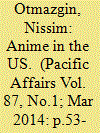|
|
|
Sort Order |
|
|
|
Items / Page
|
|
|
|
|
|
|
| Srl | Item |
| 1 |
ID:
128476


|
|
|
|
|
| Publication |
2014.
|
| Summary/Abstract |
In the past two decades, the enthusiastic global reception of Japanese cultural exports has drawn wide academic attention. In the case of Japanese animation ("anime"), its penetration into the United States, the world's biggest media market, has been described as owing greatly to the crucial role of fans as cultural agents, the deterritorializing effects of globalization, the domestication and heavy editing of anime to suit local tastes, and being part of the wider global flow of Japanese pop culture and "soft power." Drawing on interviews with Japanese and American key personnel in the anime industry, field research and market surveys, this paper focuses on the organizational aspect of the anime market in the United States since the mid-1990s, with particular attention to the role of entrepreneurs, who are imperative for bridging organizational rigidities and cultural differences in global markets. The central argument presented is that entrepreneurship is a central feature in the process of transnational penetration, distribution, reproduction and consumption of cultural commodities and genres, which produce ever more complex and disjunctive economic, cultural and political orders.
|
|
|
|
|
|
|
|
|
|
|
|
|
|
|
|
| 2 |
ID:
099989


|
|
|
|
|
| Publication |
2010.
|
| Summary/Abstract |
This article uses the U.S. reception of Japanese animation, or anime, to explore the impact of cultural globalization within the United States in the 1970s and 1980s. It introduces historians to the medium of anime, describing the transpacific appeal of several representative texts from the period. Anime exhibited characteristics that made it both Japanese and global, yet it also reproduced Western racial and gender hierarchies, allowing it to cross borders easily. The second half of the article discusses the creation of local anime fan communities throughout the United States beginning in 1977. These communities socialized locally in fan clubs, connected nationally at conventions and through networks of science-fiction fans, and participated in the construction of transnational cultural identities. Examples of underground anime literature illustrate how fan's envisioned their local, national, and transnational communities. The article concludes with suggestions for rethinking U.S. cultural relations in the postwar era.
|
|
|
|
|
|
|
|
|
|
|
|
|
|
|
|
|
|
|
|
|